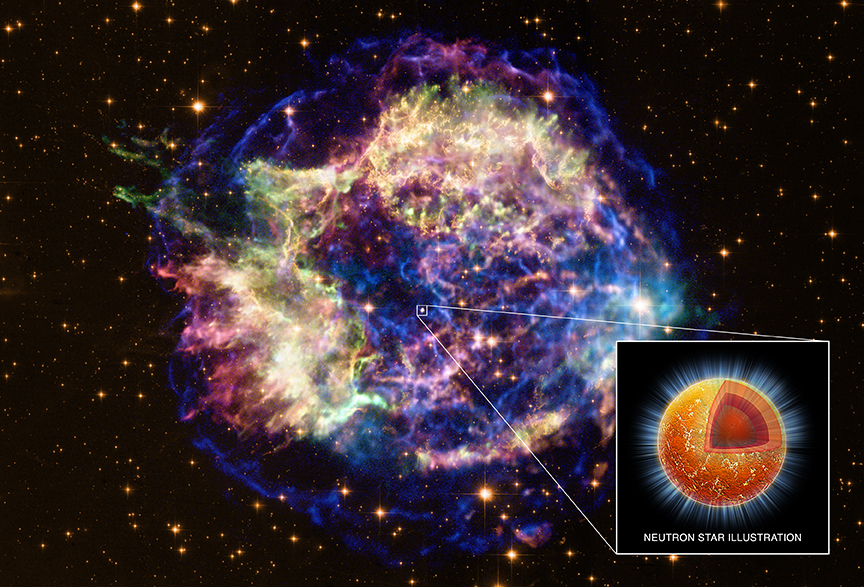Super...what?
Chandra has been able to take a glimpse at a Neutron star and the results show that...
the universe might be giving us one of the most amazing gifts of all time.
Chandra is the name of the X-ray space observatory telescope which orbits Earth at an altitude of 139,000 km, almost one third the distance to the moon.
"NASA's premier X-ray observatory was named the Chandra X-ray Observatory in honor of the late Indian-American Nobel laureate, Subrahmanyan Chandrasekhar (pronounced: su/bra/mon'/yon chandra/say/kar). Known to the world as Chandra (which means "moon" or "luminous" in Sanskrit), he was widely regarded as one of the foremost astrophysicists of the twentieth century." (NASA)
This observatory has been working since 1999, giving new insights of the outside world, by detecting high energy phenomena that could help us understand a bit more of our Universe.
But what does all these has to do with Superfluidity?
Well, recently, while Chandra was gazing through the sky, scientists found something rather special: Neutron Stars might be hiding more than we thought.
A Neutron Star, as its name says, is highly massive star, made of neutrons. Come again? Yes, you read correctly, these massively dense stars are only made up of neutrons. These stars' core pressure is to intense, that electrons and protons merge until they become neutrons. Reason why they are called Neutron stars.
But the interesting part of all these, is that scientists found a drop of a four percent in Cassiopeia A, or commonly known as Cas A, temperature, in only ten years.Cas A is the remaining neutron star of a supernova.
Something didn't make sense for scientists, how come a super massive neutron star could be running out of temperature?
There could only be one explanation: Superluids!
 |
| Heike Kamerlingh Onnes |
Superfluids are those fluids that present extremely strange behaviour at very low temperatures. The first person to unveil this type of behaviours, was Heike Kamerlingh Onnes, the dutch physicist and 1913 Nobel physics laureate. He was able to refrigerate helium, and discovered that astonishingly, at the temperature of -270.92 degrees C (known as Lambda point) , it was very good heat conductor.
But it was not until Pyotr Kapitsa digged a bit more into this strange behaviour in helium and found out something even more surprising:
the resistance to flow (or viscosity) was so low that he named it a superfluid, to describe it—after "superconductor," the term for a material that conducts very high electric currents without resistance.
 |
| Pyotr Kapitsa |
But what is so amazing about superfluids, apart from the low viscosity?
1. If you place this superfluid in a container, lets say a test tube, it will go up against gravity.
2.If you were (hypothetically speaking) able to stir this superfluid with your finger, once you stop doing it, this superfluid would continue like that for millions of years before stopping.
3.It presents such strange behaviours, that if you were to place it again at a test tube, and direct a beam of light on the closed side, you would be witnessing a frictionless never-ending fountain. Because the superfluid would flow without any friction.
Got the idea why superfluids are so special?
But now, why does this happen?
When helium is taken to such low temperature, the Bose-Einstein condensation takes place. This means that, once the helium has been refrigerated at that extreme temperature, all of its particles begin to arrange in such a way that they all behave as one single big molecule.
Here is a video so that you can understand a bit more of what I am talking about:
Do you see now why scientists are so concerned about neutron stars?
No you don't, because I haven't tell you yet the best part:
Chandra X-ray observatory captured this drop in temperature, remember? Well scientists have said that this could only be the result of presence of superfluids at the neutron star's inner core. But the most amazing detail is that how come such a special star has a superfluid at extremely high (not low) temperatures?
And also, scientists had found previous remains of superfluids, but at neutron star's crust.
Questions we still need to answer...
How come neutron stars contain superfluids, in their core...if they are exposed at billions of degrees celsius?
Why do neutron stars have superfluids at their inner core?
Could superfluids be some sort of star fuel?
We can only know in time, but at least today we learned something new.
I hope you enjoyed.
Here is a NASA animation of how it would look like if you were near the Neutron Star:
Thanks!
**Don´t forget to leave a comment, your opinion is important.
I.

No comments:
Post a Comment